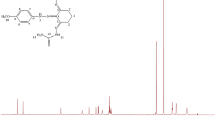Abstract
Cyanocobalamin (CNCbl), a medicinal form of vitamin B12, is resistant to glutathione (GSH), and undergoes intracellular processing via reductive decyanation producing the Co(II)-form of Cbl (Cbl(II)) mediated by the CblC-protein. Alteration of the CblC-protein structure might inhibit CNCbl processing. Here, we showed that introducing a bromine atom to the C10-position of the CNCbl corrin ring facilitates its reaction with GSH leading to the formation of Cbl(II) and cyanide dissociation. In a neutral medium, the reaction between C10-Br-CNCbl and GSH proceeds via the complexation of the reactants further leading to dimethylbenzimidazole (DMBI) substitution and electron transfer from GSH to the Co(III)-ion. The reaction is accelerated upon the GSH thiol group deprotonation. The key factors explaining the higher reactivity of C10-Br-CNCbl compared with unmodified CNCbl towards GSH are increasing the electrode potential of CNCbl two-electron reduction upon meso-bromination and the substantial labilization of DMBI, which was shown by comparing their reactions with cyanide and the pKa values of DMBI protonation (pKa base-off). Aquacobalamin (H2OCbl) brominated at the C10-position of the corrin reacts with GSH to give Cbl(II) via GSH complexation and subsequent reaction of this complex with a second GSH molecule, whereas unmodified H2OCbl generates glutathionyl-Cbl, which is resistant to further reduction by GSH.
Graphical abstract











Similar content being viewed by others
Abbreviations
- C10-Br-CNCbl:
-
CNCbl brominated at C10-position of corrin ring
- C10-Br-H2OCbl:
-
H2OCbl brominated at C10-position of corrin ring
- Cbi:
-
Cobinamide
- Cbl:
-
Cobalamin
- CNCbl:
-
Cyanocobalamin
- DMBI:
-
5,6-Dimethylbenzimidazole
- GSCbl:
-
Glutathionylcobalamin
- GSH:
-
Glutathione
- H2OCbl:
-
Aquacobalamin
- C10-Br-SO3Cbl:
-
Sulfitocobalamin brominated at C10-position of corrin ring
References
Dereven’kov IA, Salnikov DS, Silaghi-Dumitrescu R, Makarov SV, Koifman OI (2016) Redox chemistry of cobalamin and its derivatives. Coord Chem Rev 309:68–83. https://doi.org/10.1016/j.ccr.2015.11.001
Salnikov DS, Kucherenko PN, Dereven’kov IA, Makarov SV, van Eldik R (2014) Kinetics and mechanism of the reaction of hydrogen sulfide with cobalamin in aqueous solution. Eur J Inorg Chem. https://doi.org/10.1002/ejic.201301340
Salnikov DS, Dereven’kov IA, Artyushina EN, Makarov SV (2013) Interaction of cyanocobalamin with sulfur-containing reducing agents in aqueous solutions. Russ J Phys Chem A 87:44–48. https://doi.org/10.1134/S0036024413010226
Dereven’kov IA, Ugodin KA, Makarov SV (2021) Mechanism of the reaction between cyanocobalamin and reduced flavin mononucleotide. Russ J Phys Chem A 95:2020–2024. https://doi.org/10.1134/S003602442110006X
Lexa D, Savéant JM, Zickler J (1980) Electrochemistry of vitamin B12. 5. Cyanocobalamins. J Am Chem Soc 102:2654–2663. https://doi.org/10.1021/ja00528a023
Kim J, Gherasim C, Banerjee R (2008) Decyanation of vitamin B12 by a trafficking chaperone. Proc Natl Acad Sci USA 105:14551–14554. https://doi.org/10.1073/pnas.0805989105
Koutmos M, Gherasim C, Smith JL, Banerjee R (2011) Structural basis of multifunctionality in a vitamin B12-processing enzyme. J Biol Chem 286:29780–29787. https://doi.org/10.1074/jbc.M111.261370
Esser AJ, Mukherjee S, Dereven’kov IA, Makarov SV, Jacobsen DW, Spiekerkoetter U, Hannibal L (2022) Versatile enzymology and heterogeneous phenotypes in cobalamin complementation type C disease. IScience 25:104981. https://doi.org/10.1016/j.isci.2022.104981
Wingert V, Mukherjee S, Esser AJ, Behringer S, Tanimowo S, Klenzendorf M, Derevenkov IA, Makarov SV, Jacobsen DW, Spiekerkoetter U, Hannibal L (2021) Thiolatocobalamins repair the activity of pathogenic variants of the human cobalamin processing enzyme CblC. Biochimie 183:108–125. https://doi.org/10.1016/j.biochi.2020.10.006
Wierzba AJ, Wincenciuk A, Karczewski M, Vullev VI, Gryko D (2018) meso-Modified cobalamins: synthesis, structure, and properties. Chem Eur J 24:10344–10356. https://doi.org/10.1002/chem.201801807
Knapton L, Marques HM (2005) Probing the nature of the Co(III) ion in cobalamins: a comparison of the reaction of aquacobalamin (vitamin B12a) and aqua-10-chlorocobalamin with some anionic and N-donor ligands. Dalton Trans. https://doi.org/10.1039/B416083E
Marques HM (2023) The inorganic chemistry of the cobalt corrinoids—an update. J Inorg Biochem 242:112154. https://doi.org/10.1016/j.jinorgbio.2023.112154
Prieto L, Rossier J, Derszniak K, Dybas J, Oetterli RM, Kottelat E, Chlopicki S, Zelder F, Zobi F (2017) Modified biovectors for the tuneable activation of anti-platelet carbon monoxide release. Chem Commun 53:6840–6843. https://doi.org/10.1039/C7CC03642F
Wagner F (1965) Reactions of the cyano and alkyl cobalamins. Proc Royal Soc A 288:344–347. https://doi.org/10.1098/rspa.1965.0225
Brown KL, Cheng S, Zou X, Zubkowski JD, Valente EJ, Knapton L, Marques HM (1997) Cis effects in the cobalt corrins. 1. Crystal structures of 10-chloroaquacobalamin perchlorate, 10-chlorocyanocobalamin, and 10-chloromethylcobalamin. Inorg Chem 36:366–3675. https://doi.org/10.1021/ic9615077
Dereven’kov IA, Osokin VS, Hannibal L, Makarov SV, Khodov IA, Koifman OI (2021) Mechanism of cyanocobalamin chlorination by hypochlorous acid. J Biol Inorg Chem 26:427–434. https://doi.org/10.1007/s00775-021-01869-5
Ghadimi N, Perry CB, Fernandes MA, Govender PP, Marques HM (2015) Probing the nature of the Co(III) ion in cobalamins: the reactions of aquacobalamin (vitamin B12a), aqua-10-chlorocobalamin and aqua-10-bromocobalamin with anionic and neutral ligands. Inorg Chim Acta 436:29–38. https://doi.org/10.1016/j.ica.2015.07.019
Brenig C, Mosberger L, Baumann K, Blacque O, Zelder F (2021) Redox-neutral syntheses and electrochemical studies of 10-bromo-substituted light-stable antivitamin B12 candidates. Helv. Chim. Acta 104:e2100067. https://doi.org/10.1002/hlca.202100067
Navizet I, Perry CB, Govender PP, Marques HM (2012) cis influence in models of cobalt corrins by DFT and TD-DFT studies. J Phys Chem B 116:8836–8845. https://doi.org/10.1021/jp304007a
Zelder F, Sonnay M, Prieto L (2015) Antivitamins for medicinal applications. ChemBioChem 16:1264–1278. https://doi.org/10.1002/cbic.201500072
Brenig C, Mestizo PD, Zelder F (2022) Functionalisation of vitamin B12 derivatives with a cobalt β-phenyl ligand boosters antimetabolite activity in bacteria. RSC Adv 12:28553–28559. https://doi.org/10.1039/D2RA05748D
Xia L, Cregan AG, Berben LA, Brasch NE (2004) Studies on the formation of glutathionylcobalamin: any free intracellular aquacobalamin is likely to be rapidly and irreversibly converted to glutathionylcobalamin. Inorg Chem 43:6848–6857. https://doi.org/10.1021/ic040022c
Hannibal L, Axhemi A, Glushchenko AV, Moreira ES, Brasch NE, Jacobsen DW (2008) Accurate assessment and identification of naturally occurring cellular cobalamins. Clin Chem Lab Med 46:1739–1746. https://doi.org/10.1515/CCLM.2008.356
Jeong J, Park J, Park J, Kim J (2014) Processing of glutathionylcobalamin by a bovine B12 trafficking chaperone bCblC involved in intracellular B12 metabolism. Biochem Biophys Res Commun 443:173–178. https://doi.org/10.1016/j.bbrc.2013.11.075
Kim J, Hannibal L, Gherasim C, Jacobsen DW, Banerjee R (2009) A human vitamin B12 trafficking protein uses glutathione transferase activity for processing alkylcobalamins. J Biol Chem 284:33418–33424. https://doi.org/10.1074/jbc.M109.057877
Calafat AM, Marzilli LG (1993) Investigations of B12 derivatives with inorganic ligands using 2D NMR spectroscopy. Ligand responsive shifts suggest that the deoxyadenosyl moiety in coenzyme B12 has a steric trans influence. J Am Chem Soc 115:9182–9190. https://doi.org/10.1021/ja00073a037
Zhou K, Zelder F (2011) One-step synthesis of α/β cyano-aqua cobinamides from vitamin B12 with Zn(II) or Cu(II) salts in methanol. J Porphyr Phthalocyanines 15:555–559. https://doi.org/10.1142/S1088424611003446
Zhou K, Zelder F (2011) Identification of diastereomeric cyano-aqua cobinamides with a backbone-modified vitamin B12 derivative and with 1H NMR spectroscopy. Eur J Inorg Chem. https://doi.org/10.1002/ejic.201001146
Munegumi T (2013) Where is the border line between strong acids and weak acids? World J Chem Edu 1:12–16
Liu M, Mao X, Ye C, Huang H, Nicholson JK, Lindon JC (1998) Improved WATERGATE pulse sequences for solvent suppression in NMR spectroscopy. J Magn Res 132:125–129. https://doi.org/10.1006/jmre.1998.1405
Rabenstein DL (1973) Nuclear magnetic resonance studies of the acid-base chemistry of amino acids and peptides. I. Microscopic ionization constants of glutathione and methylmercury-complexed glutathione. J Am Chem Soc 95:2797–2803. https://doi.org/10.1021/ja00790a009
Dereven’kov IA, Salnikov DS, Shpagilev NI, Makarov SV, Tarakanova EN (2012) Reactions of cobinamide with glucose and fructose. Macroheterocycles 5:260–265. https://doi.org/10.6060/mhc2012.120884m
Dereven’kov IA, Osokin VS, Molodtsov PA, Makarova AS, Makarov SV (2022) Effect of complexation between cobinamides and bovine serum albumin on their reactivity toward cyanide. React Kinet Mech Catal 135:1469–1483. https://doi.org/10.1007/s11144-022-02216-8
Sobornova VV, Belov KV, Dyshin AA, Gurina DL, Khodov IA, Kiselev MG (2022) Molecular dynamics and nuclear magnetic resonance studies of supercritical CO2 sorption in poly(methyl methacrylate). Polymers 14:5332. https://doi.org/10.3390/polym14235332
Singh K, Kumar SP, Blümich B (2019) Monitoring the mechanism and kinetics of a transesterification reaction for the biodiesel production with low field 1H NMR spectroscopy. Fuel 243:192–201. https://doi.org/10.1016/j.fuel.2019.01.084
Carneiro de Oliveira J, Laborie M-P, Roucoules V (2020) Thermodynamic and kinetic study of diels-alder reaction between furfuryl alcohol and N-hydroxymaleimides—an assessment for materials application. Molecules 25:243. https://doi.org/10.3390/molecules25020243
Izatt RM, Christensen JJ, Pack RT, Bench A (1962) Thermodynamics of metal-cyanide coordination. I. pK, ΔH0, and ΔS0 values as a function of temperature for hydrocyanic acid dissociation in aqueous solution. Inorg Chem 1:828–831. https://doi.org/10.1021/ic50004a022
Hamza MSA, Zou X, Brown KL, van Eldik R (2002) Detailed kinetic and thermodynamic studies on the cyanation of alkylcobalamins. A generalized mechanistic description. J Chem Soc Dalton Trans. https://doi.org/10.1039/B206706D
Brown KL, Hakimi JM, Jacobsen DW (1984) Heteronuclear NMR studies of cobalamins. 3. Phosphorus-31 NMR of aquocobalamin and various organocobalamins. J Am Chem Soc 106:7894–7899. https://doi.org/10.1021/ja00337a043
Brown KL, Hakimi JM (1984) Heteronuclear NMR studies of cobalamins. 2. Carbon-13 and phosphorus-31 NMR studies of [13C]cyanocobalamin. Inorg Chem 23:1756–1764. https://doi.org/10.1021/ic00180a022
Dereven’kov IA, Shpagilev NI, Makarov SV (2018) Mechanism of the reaction between cobalamin(II) and periodate. Russ J Phys Chem A 92:2182–2186. https://doi.org/10.1134/S0036024418110080
Lexa D, Savéant JM (1983) The electrochemistry of vitamin B12. Acc Chem Res 16:235–243. https://doi.org/10.1021/ar00091a001
Hinze R-P, Schiebel HM, Laas H, Heise K-P, Gossauer A, Inhoffen HH, Ernst L, Schulten H-R (1979) Beiträge zur Kenntnis des chromophoren Systems der Corrine, IV. Über die partielle, reversible Ringöffnung am Dicyano-cobyrinsäure-heptamethylester mit intermediärer reversible Entfernung des Cobalts. Liebigs Ann Chem 1979:811–825. https://doi.org/10.1002/jlac.197919790611
Acknowledgements
This research was funded by the Russian Science Foundation (Project no. 19-73-00147) to IAD. MALDI-mass-spectrometry experiments were carried out using the resources of the Center for Shared Use of Scientific Equipment of the ISUCT (with the support of the Ministry of Science and Higher Education of Russia, Grant No. 075-15-2021-671).
Author information
Authors and Affiliations
Contributions
IAD was responsible for investigation, funding acquisition, and writing—original draft preparation. VSO, IAK, VVS, and NAE were responsible for investigation. SVM was responsible for supervision, and writing—review & editing.
Corresponding author
Ethics declarations
Conflict of interest
The authors declare no conflict of interest.
Additional information
Publisher's Note
Springer Nature remains neutral with regard to jurisdictional claims in published maps and institutional affiliations.
Supplementary Information
Below is the link to the electronic supplementary material.
Rights and permissions
Springer Nature or its licensor (e.g. a society or other partner) holds exclusive rights to this article under a publishing agreement with the author(s) or other rightsholder(s); author self-archiving of the accepted manuscript version of this article is solely governed by the terms of such publishing agreement and applicable law.
About this article
Cite this article
Dereven’kov, I.A., Osokin, V.S., Khodov, I.A. et al. meso-Bromination of cyano- and aquacobalamins facilitates their processing into Co(II)-species by glutathione. J Biol Inorg Chem 28, 571–581 (2023). https://doi.org/10.1007/s00775-023-02009-x
Received:
Accepted:
Published:
Issue Date:
DOI: https://doi.org/10.1007/s00775-023-02009-x




